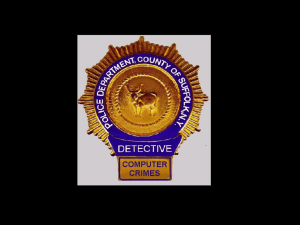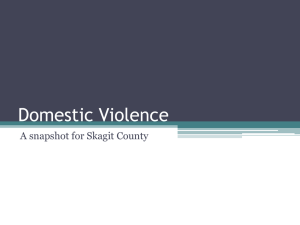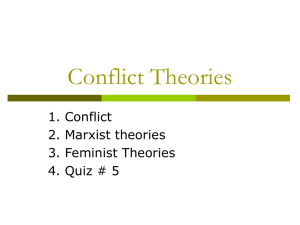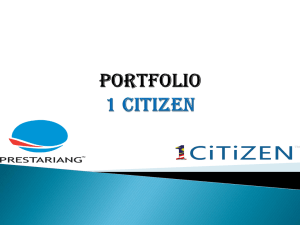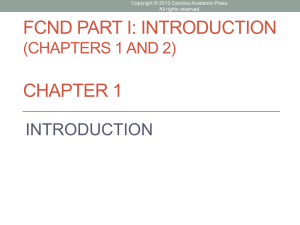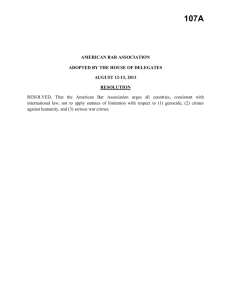Control Balance
advertisement
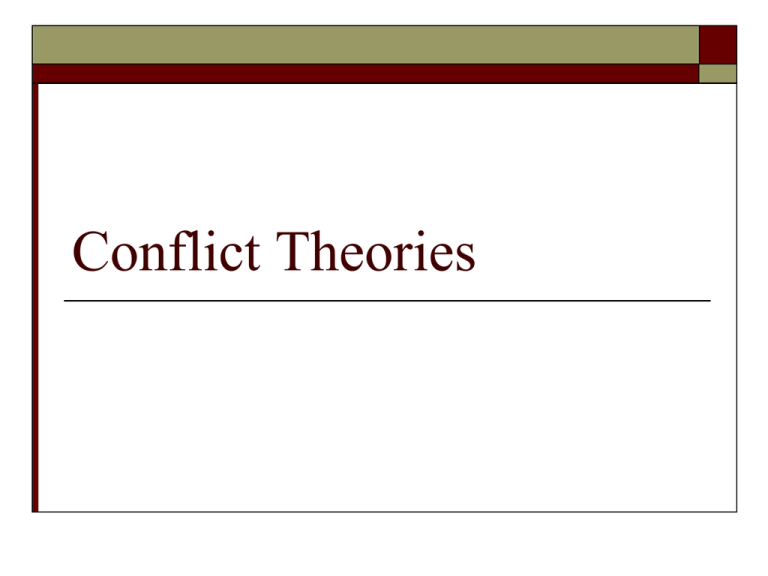
Conflict Theories Understanding Conflict Conflict is a natural disagreement resulting from individuals or groups that differ in attitudes, beliefs, values or needs What is conflict? Conflict Theory Opposite to the consensus theory There is little agreement on basic values Society is made up of many competing groups, each with different interests Law is a weapon that the powerful use to enforce their private interests, often at the expense of the public interest Conflict Theory Class conflict Different social classes can be distinguished by inequalities in such areas as power, authority, wealth, working and living conditions, life-styles, life-span, education, religion, and culture Law and Justice Vehicles for controlling the poor They help powerful and rich to impose their particular morality and standards of good behavior to the entire society Laws protecting private property may actually be designed to preserve the dominance of a ruling elite “Stand Your Ground” law Law authorizes the use of defensive force by anyone who is not engaged in an unlawful activity and who is attacked in the place where he or she has a right to be (inside their home, the backyard, detached garage, or a pole building) and when a person reasonably believes it necessary to prevent the commission of a "forcible felony“ without fear of criminal or civil consequences “Stand Your Ground” law. The following three valid reasons to use deadly force apply to all situations: 1. 2. 3. Fear of Death Fear of Serious Bodily Injury Fear of Forcible Sexual Penetration Fatal incident (October 17, 1992) Yoshihiro Hattori went dressed in a tuxedo in imitation of Travolta from Saturday Night Fever The boy mistook the Peairs' residence for the intended destination due to the similarity of the address Hattori was shot in the chest at close range by the owner of the house The Criminal Trial of Peairs At the trial, Peairs said: "It was a person, coming from behind the car, moving real fast. At that point, I pointed the gun and hollered, 'Freeze!' The person kept coming toward me, moving very erratically. I remember him laughing. I was scared to death. This person was not gonna stop, he was gonna do harm to me.“ "I had no choice," he said. "I want Yoshi's parents to understand that I'm sorry for everything." The Criminal Trial of Peairs The trial lasted seven days. After the jurors deliberated for three and a quarter hours, Peairs was acquitted under Louisiana's "Kill the burglar "statute. In a later civil action, the court found Peairs liable to Hattori's parents for $650,000 damages. Louisiana’s “Kill the carjacker” statute Considering the amount of time people spend in their automobiles, the vehicle is viewed as an extension of the home “Kill the burglar” statute was applied to carjacking to permit the use of deadly force against actual or attempted carjacking. “Kill the Carjacker” statute (1997) The statute justifies homicide committed by a passenger or driver inside the vehicle against an individual who is attempting to unlawfully enter the vehicle, if the passenger or driver “reasonably believes” that deadly force is necessary either to prevent the individual’s unlawful entry or to force the individual out of the vehicle (note: no imminent danger of death is mentioned) The law is controversial Some call it “a license to kill” Others view it as an important form of protection for innocent automobile drivers Many think that the statute will become “lynch law” because they believe the most carjackers-the potential victims of the ”Kill the Carjacker” statuteare Black persons. The Louisiana legislature prioritized the value of an automobile over the value of human life “Kill the Carjacker” is dangerous It justifies homicide for the sake of protecting mere personal property The Statute puts anyone approaching a vehicle at risk of being shot and makes motorists under age of twenty-one, who cannot carry concealed weapons, primary targets of carjacking The poor are driven to crime because… A natural frustration exits in a society where affluence is well publicized but unattainable to the majority of citizens A deep-rooted hostility is generated among members of the lower class toward a social order that they are not allowed to shape and participate in it Richard Quinney: Class, State, and Crime (1980) Crime is an inevitable response to the material conditions of capitalism Crimes of working class: “crimes of accommodation” or “crimes of resistance” Crimes of accommodation are predatory crimes, such as burglary and robbery (reproduce the capitalistic system) and violent crimes, such as murder, assault, and rape committed by those who are “brutalized” by capitalism Richard Quinney: Class, State, and Crime (1980) Crimes of resistance include both nonrevolutionary, unconscious reactions against exploitation and crimes deliberately committed by proletariat as acts of rebellion against capitalism Alcoholism, destroying property, fighting, etc. Quinney on the ruling class Crimes committed by the ruling class are the result of the capitalistic system as well “Crimes of domination and repression” committed by capitalists to protect their interests Examples: corporate crimes (price fixing, bid rigging, security violation) “Crimes of control” are committed by criminal justice personnel (protection the ruling class’s effort to ensure its continued domination) Policy Recommendation There can be no solution to crime under capitalistic society All classes are affected by the egoism and greed produced by capitalism Change the society/make it more humane Tittle’s Control Balance Theory Control theorists focus on the factors that “restrain” the behavior of individuals Tittle made an innovation by arguing that people are not only objects of control but also agents of control Each person has a certain amount of control that she/she is under and a certain amount of control she/he exerts Tittle’s Control Balance Theory Tittle sought to have a “General Theory” and thus to explain all forms of deviance For some, the relative amount of control is in balance (Control Balance ) Some suffer from deficit of control and others experience a control surplus (Control Imbalance) Control balance is associated with conformity and Control imbalance tends to be associated with deviance Tittle’s Control Balance Theory Submission Defiance Predation Balance Exploitation Plunder Decadence Conformity Repression Autonomy Tittle’s Control Balance Theory vandalism Submission Serious forms of crime White-collar crimes Defiance Predation Balance Exploitation Plunder Decadence Conformity Repression Autonomy Tittle’s Control Balance Theory Predisposition to deviance is in each of us Human nature has a strong urge for autonomy (to escape the control that others wish to impose on us) Motivation appears when two conditions transpire: a person becomes aware of his/her control imbalance and realize that deviant behavior can change this imbalance and person must experience" negative emotion” of being humiliated or denigrated Tittle’s Control Balance Theory Once motivation has emerged, deviant behavior still might not occur Opportunity must be present Constraints (fear of being caught, moral ambitions, social bonds) also must be overcome

